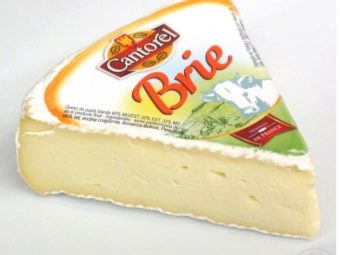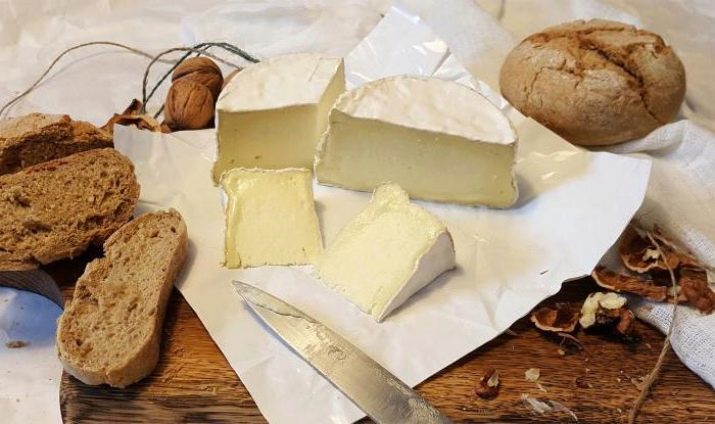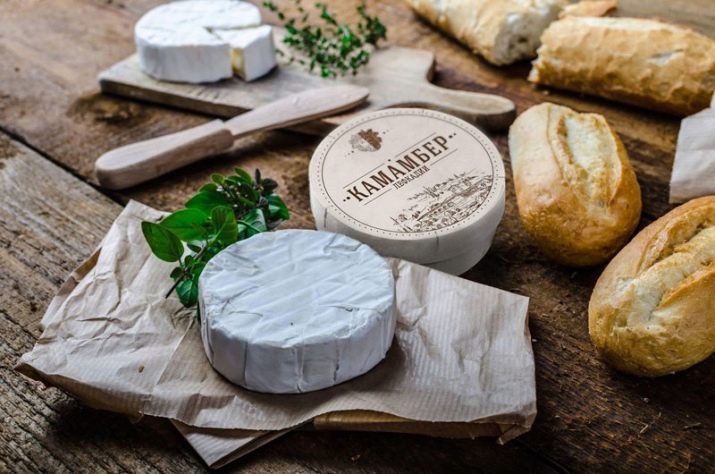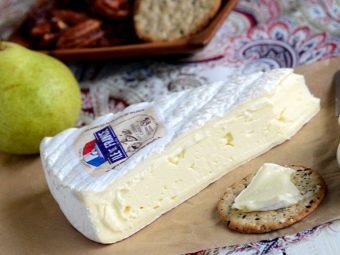Camembert and Brie: how does one cheese differ from another, which one tastes better and what does it eat?
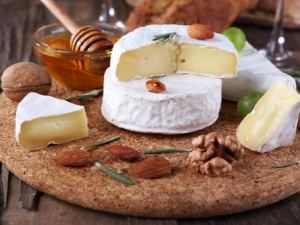
At first glance, the Camembert and Brie cheeses are exactly the same: both are made in France, both are covered with mold, and both have approximately a similar taste. However, there is still a slight difference between them.
What it is?
Camembert is a soft and sometimes semi-hard cheese that is usually made from cow's milk. Brie is also a soft cheese made from cow's milk, but it was created earlier than Camembert, so many people consider it to be the basis for the second variety. In preparation, similar technologies are used in principle. Mold in both species looks like a dense skin.
Appearance
The color of Camembert varies from white to the color of delicate cream with numerous shades. The darker the colors, the longer was the time spent on the ripening of the cheese. The shade of a moldy crust is white. The difference between Brie cheese lies in the color of the head - it is painted in a grayish-gray hue. A moldy crust looks differently - although it has the same white color, it is also covered with reddish lines.
It is worth mentioning that the Brie moldy component is harder and even crumbly, and Camembert is soft and pleasant to the touch.
Taste and smell
The taste of Camembert is sweetish, and the smell is reminiscent of something fresh champignons. True, there are versions that smell the product and hay, and earth, and asphalt, and even a cattle yard with cows. Exact amber depends on how the manufacturing technology was carried out. Of course, many gourmets such a smell is banal scares. The taste of Brie is much more refined - it is pretty spicy, salty, combining both tenderness and sharpness.
The latter characteristic, by the way, depends on the head ripening time and on its appearance: the higher its height, the calmer the taste. By smell, this species is somewhat reminiscent of hazelnuts or something oily. Brie's crust may remind ammonia to someone by smell, which, of course, will scare away the buyer. It is rather neutral in taste. Camembert crust is much tastier - it is quite sharp and smells of mushrooms, like the main part of the product. Finally, Brie is often supplemented with spicy herbs, nuts and dried fruits, and Camembert is purchased in its pure form.
Other characteristics
The Camembert circle always has fixed dimensions: three centimeters high and eleven centimeters in diameter. The weight of such a piece corresponds to 250 grams. The fat content of this type of cheese is quite high. Brie cheese is also different in size: both height and diameter may be different. The first indicator ranges from three to five centimeters, and the diameter is from thirty to sixty centimeters.
Seeing an impressive circle of dairy product, you can immediately understand that it belongs to the second type of cheese. In addition, the Brie head may seem oval, and Camembert will always be flat round.
Bree's fat content, on the contrary, is much less than that of Camembert - almost a quarter. As part of the technology, both cheeses require the use of cream: Brie cheese in the amount of 65% of the total composition, and Camembert cheese in the amount of 45% of the total composition. It is also important to add that in Brie, sour milk cultures are added only once, and five times more in Camembert. It is important to mention that Brie, unlike Camembert, is not afraid of storage in the refrigerator - it will not lose its excellent taste, and its consistency will not change. Camembert in the refrigerator will harden and will require additional manipulations before serving.
Harm and Benefit
Camembert cheese is characterized by the presence of a significant amount of essential amino acids. Because of this, it allows people under constant stress and stress to recover their strength.The composition also contains phosphorus and potassium, which explains the need for its consumption in situations such as broken limbs and other injuries, arthrosis and arthritis. The qualitative effect will appear in the state of the nervous system, as well as the teeth. Also, the product is recommended to give adolescents, whose body is actively developing.
Unlike many other dairy products, Camembert is not forbidden to use in case of lactose intolerance, as this substance is contained in a minimum quantity. The occurrence of allergic reactions is very unlikely. However, this product should not be used by pregnant women and children under the age of seven, as in their situations listeriosis infection is possible.
It is worthwhile to warn people suffering from pressure surges, as well as high cholesterol. Of course, the product should not be abused individuals with excess weight. In general, experts recommend a daily dose of such cheese in the amount of fifty grams.
Significant benefits to the body delivers and Brie cheese. It is saturated with phosphorus and potassium, which benefits the bone system. Mention should also be made of vitamin A saturation, which is known to improve the condition of the skin through the synthesis of collagen, and also strengthens the eyesight. Vitamin B normalizes the state of the nervous and cardiovascular systems, copes with insomnia and fills with strength. There is even a hypothesis that the regular use of the product in food prevents the occurrence of caries and strengthens the ability of the skin not to suffer from excessive ultraviolet radiation.
The absence of lactose allows you to use the product without fear of allergies. However, the product is not recommended for small children, pregnant women and women who are in the period of lactation. Some danger is also possible when a person has an unhealthy cardiovascular system, as well as being overweight. As for the recommended dose, it, as in the case of Camembert, is fifty grams per day.
Production
Brie cheese can be made for twelve months. Camembert cheese is far more fastidious in this matter: it feels bad at high temperatures, therefore its production stops during the summer months, and in September it resumes again. It is worth mentioning that Camembert is kept for six to eight weeks before being sold on the shelves, and Brie does not need such a procedure. Thus, the second product can be tasted one month after the start of the workflow, which cannot be said about the first. By the way, this process is called refining.
There is a difference in the choice of the basic product: Brie is made from warmed and salted cow's milk. To prepare Camembert, you will need selected milk in which salt and rennet enzymes have been previously added.
Special requirements are imposed on the packaging - the cheese is always placed in a box made of wood. This packaging makes it easy to transport the product. With regards to Bree there are no conditions. The cost of products is only slightly different: 250 grams of Camembert cost about four hundred and fifty rubles, and the second variety - about five hundred rubles.
What do you eat?
Camembert is a rather fat product, therefore, getting into the space with low temperature for a long time, it freezes and loses its outstanding characteristics. This explains why, before serving, the cheese must be placed in a warmer place and allowed to stand for thirty minutes. However, until the cheese is softened, you can do cutting into segments - cubes or slices. If you put off cutting "for later", then you can make a small presentation - in contact with a knife from the head there will be a middle section that looks extremely tempting.
Usually this type of cheese is offered with nuts, for example, walnuts, fruits and jam, having a slight sourness.The latter includes such tastes as lingonberry and raspberry. Like other blue cheeses, Camembert is considered an excellent component of a cheese plate. Among alcoholic drinks, professionals recommend choosing red wine or cider with cheese. Despite some elitism of this product, it is quite possible to use cheese for making ordinary crispy sandwiches or as part of the cake. The melted product is often used to make fondue to further lower pieces of fruit or crispy bread into a thick mass.
Brie cheese is also combined with nuts, fruit and fresh baguette. Often it is combined with fig jam, honey or even a berry non-alcoholic beverage. When forming a cheese plate, you can add almonds or other candied nuts, as well as crispy crackers. The main drink offered to Brie is champagne. Dry white wines, cider and even beer are also suitable.
It is important that the taste of the drink does not interrupt the shades of cheese. Those who do not consume alcohol are advised to turn their attention to apple juice. Although Brie, like Camembert, often becomes a filling for pies, it can also be used to prepare fish dishes, such as salmon, pesto sauce and cheese sauce.
A review of Brie, Camembert and Roquefort cheeses is waiting for you in the video below.

